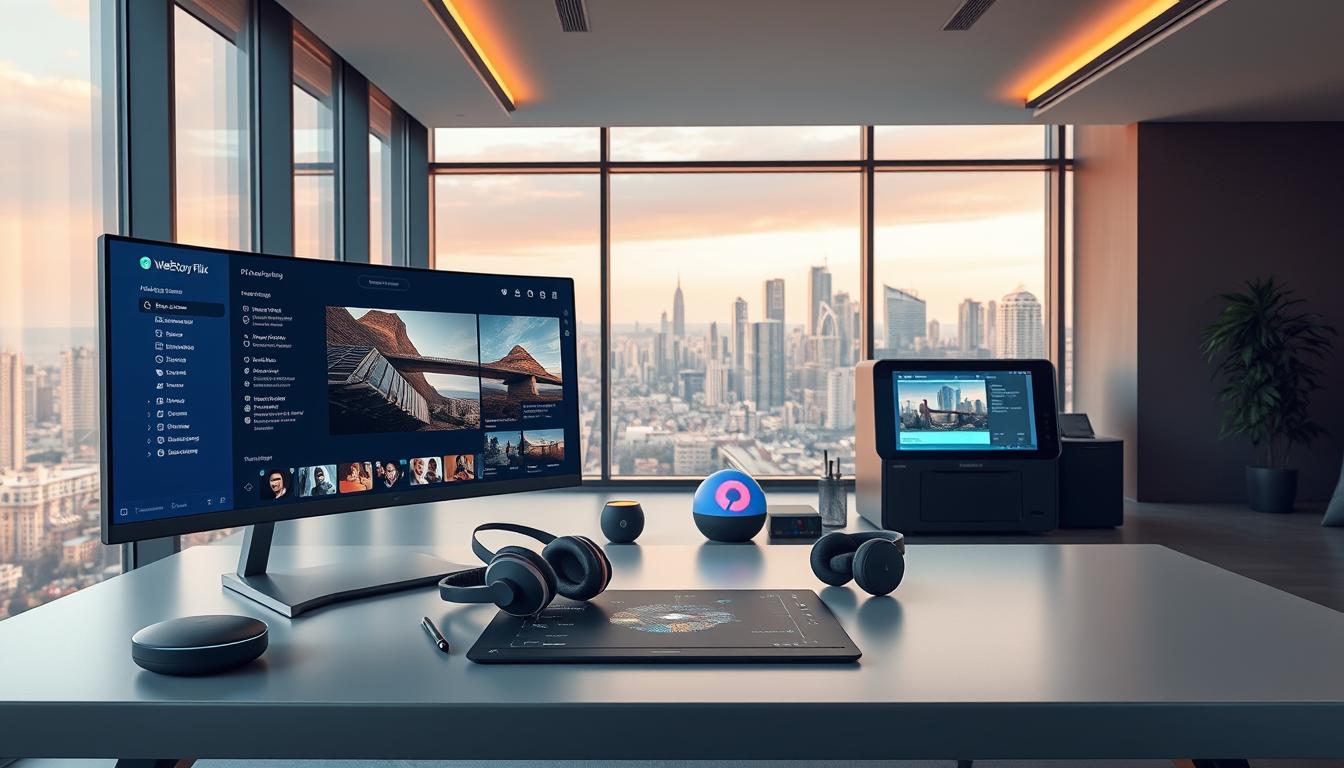Did you know that AI can reduce task completion time by up to 50%? This isn’t just a futuristic idea—it’s happening now. From chatbots to coding assistants, these innovations are reshaping how we work.
Over the past few years, AI has evolved from a buzzword to a core business asset. Companies across industries are leveraging its power to automate repetitive tasks and enhance creative outputs. Tools like ChatGPT, Google Gemini, and Synthesia are leading the charge, offering real-world benefits that are hard to ignore.
Choosing the right tool is crucial. Whether it’s for content creation, web design, or project management, each category offers unique advantages. Scalability and integration are key factors to consider, ensuring these solutions fit seamlessly into your workflow.
As we move into 2025, AI’s role in boosting productivity and efficiency will only grow. It’s not just about saving time—it’s about working smarter and achieving more with less effort.
Key Takeaways
- AI reduces task completion time by up to 50%.
- ChatGPT, Google Gemini, and Synthesia are leading examples.
- Automation enhances both efficiency and creativity.
- Scalability and integration are critical for success.
- AI tools are essential for smarter workflows in 2025.
Introduction: Navigating the AI Productivity Landscape in 2025
Navigating the AI landscape in 2025 is essential for efficiency. Over 60% of business owners believe these innovations will boost workflows significantly. From chatbots to resume builders, these tools are reshaping how we approach daily tasks.
I’ve seen firsthand how AI balances routine and creative work. Automating repetitive tasks like email sorting and data analysis frees up valuable time. This allows teams to focus on strategic initiatives, driving better results.
However, integrating these tools isn’t without challenges. Learning curves can be steep, and adapting workflows requires effort. But the benefits—reduced response times and improved decision-making—make it worthwhile.
Industries are shifting from manual to automated processes. For example, customer support now relies on interactive AI platforms. These changes enhance productivity and ensure smoother operations.
In this article, I’ll explore key categories like chatbots, content creation, and project management. Each offers unique advantages, transforming how teams collaborate and achieve goals.
Here’s a quick overview of how AI tools are making an impact:
| Category | Key Benefit |
|---|---|
| Chatbots | Improved customer interaction |
| Content Creation | Enhanced creativity and speed |
| Project Management | Streamlined task coordination |
By 2025, AI will be a cornerstone of efficient workflows. It’s not just about saving time—it’s about working smarter and achieving more with less effort.
The best AI productivity tools by category 2025

Teams are leveraging innovative solutions to streamline workflows and enhance collaboration. From chatbots to content creation platforms, these tools are transforming how we approach daily tasks. They not only save time but also improve overall efficiency.
One standout category is chatbots. Tools like ChatGPT and Google Gemini are revolutionizing communication. They handle customer inquiries, schedule meetings, and even assist with internal queries. This allows teams to focus on more strategic initiatives.
Another critical area is content creation. Platforms like Synthesia and Jasper.ai are making it easier to produce high-quality content quickly. Whether it’s video generation or copywriting, these tools enhance creativity while reducing manual effort.
Email management has also seen significant improvements. Tools like Clean Email and SaneBox automate inbox organization, ensuring important messages are prioritized. This reduces clutter and helps teams stay on top of their communications.
Here’s a breakdown of key categories and their benefits:
| Category | Key Tools | Benefits |
|---|---|---|
| Chatbots | ChatGPT, Google Gemini | Improved communication and task automation |
| Content Creation | Synthesia, Jasper.ai | Enhanced creativity and faster output |
| Email Management | Clean Email, SaneBox | Efficient inbox organization |
These solutions are not just about saving time—they’re about empowering teams to achieve more. By integrating these tools, businesses can enhance productivity and foster better collaboration.
AI Chatbots: Revolutionizing Communication and Support
AI chatbots are reshaping how businesses interact with customers and manage internal communication. These intelligent systems are no longer just a novelty—they’re a necessity for modern operations. From handling customer inquiries to streamlining team collaboration, chatbots are making workflows smoother and more efficient.
One of the most significant advantages is their ability to reduce wait times. Customers no longer have to endure long hold times or delayed responses. Instead, chatbots provide instant answers, improving satisfaction and loyalty. For internal teams, these tools automate repetitive tasks, freeing up time for strategic initiatives.
Popular Chatbots and Their Core Benefits
ChatGPT, Google Gemini, and Claude are leading the charge in this space. Each offers unique capabilities that cater to different needs. For instance, ChatGPT excels in natural language processing, making it ideal for customer support. Google Gemini integrates seamlessly with other Google services, enhancing productivity. Claude, on the other hand, focuses on secure and ethical interactions.
Here’s a quick look at their key benefits:
- ChatGPT: Handles complex queries with ease, improving customer interaction.
- Google Gemini: Streamlines communication across platforms, boosting efficiency.
- Claude: Ensures secure and ethical conversations, building trust.
Integrating AI Assistants into Daily Workflows
Incorporating chatbots into daily operations is simpler than it seems. Many platforms offer easy integration with existing systems, ensuring a smooth transition. For example, ChatGPT can be added to websites or messaging apps, while Google Gemini works within the Google ecosystem.
The benefits are immediate. Teams experience faster response times, and customers enjoy seamless interactions. Plus, these tools learn and adapt over time, becoming even more effective with use.
From my experience, integrating chatbots has been a game-changer. They’ve not only improved efficiency but also enhanced collaboration within teams. By automating routine tasks, we’ve been able to focus on more impactful projects, driving better results for the business.
Content Creation and Web Design: Unleashing Creative AI

Creative processes are evolving rapidly with the help of intelligent systems. From generating engaging copy to designing stunning visuals, these innovations are transforming how we approach content and web design. They not only save time but also enhance creativity and streamline workflows.
AI Tools for Copywriting and Social Media Management
Jasper AI and Buffer are leading the way in copywriting and social media management. Jasper AI enables rapid creation of SEO-rich content, making it ideal for blogs and marketing campaigns. Buffer simplifies scheduling and analytics, ensuring consistent engagement across platforms.
These tools empower teams to focus on strategy rather than repetitive tasks. By automating content generation and posting, they optimize communication and reinforce brand identity. I’ve found them invaluable for maintaining a consistent voice across all channels.
Design and Image Generation Solutions
MidJourney and DALL-E are revolutionizing visual content production. These platforms generate high-quality images based on textual prompts, making them perfect for branding and web design. They eliminate the need for extensive design skills, allowing anyone to create professional visuals.
From my experience, these tools have transformed how I approach design projects. They streamline the creation process, enabling faster turnaround times without compromising quality. Whether it’s for social media or website graphics, they deliver exceptional results.
Integrating these solutions into daily work has been a game-changer. They not only enhance creativity but also improve efficiency, allowing teams to achieve more in less time. As the demand for high-quality content grows, these tools will continue to play a vital role in shaping the future of design and communication.
AI Search Engines and Research Tools: Enhancing Information Discovery
Discovering information has never been easier, thanks to AI-powered search engines. These tools are transforming the way we gather and process data, making it faster and more accurate. Whether for professional research or everyday queries, they’re reshaping how we access knowledge.
Traditional search methods often fall short when it comes to real-time data and precision. AI-driven platforms overcome these limitations by offering advanced features like semantic searches and contextual analysis. This ensures users get the most relevant results in seconds.
Advanced Search Capabilities and Real-Time Data
One of the standout features of these tools is their ability to retrieve real-time data. Platforms like ChatGPT and DeepSeek excel in providing up-to-date information, which is crucial for decision-making. They also analyze vast datasets, offering insights that would take hours to compile manually.
For instance, Elicit uses semantic searches to find academic papers even without perfect keyword matches. This way, researchers can access relevant studies faster, streamlining the literature review process. Similarly, Scite.ai provides citations with context, showing how often a claim has been supported or challenged.
From my experience, these tools have been invaluable. They’ve not only saved time but also improved the accuracy of my work. By automating data retrieval and analysis, I can focus on interpreting results rather than gathering them.
Overcoming Traditional Search Limitations
Traditional search engines often struggle with complex queries or niche topics. AI-powered solutions address this by understanding natural language and delivering precise answers. For example, Perplexity AI handles intricate questions with ease, making it ideal for professional use.
Another advantage is their ability to learn and adapt. Tools like Google Gemini improve over time, offering more accurate results based on user interactions. This ensures a seamless experience, whether you’re researching for a project or solving a personal query.
Here’s a quick comparison of leading AI search engines and their key features:
| Platform | Key Feature |
|---|---|
| ChatGPT | Natural language processing |
| DeepSeek | Real-time data retrieval |
| Perplexity AI | Complex query handling |
| Google Gemini | Seamless integration |
These tools are revolutionizing the way we discover and use information. By combining speed, accuracy, and adaptability, they’re setting a new standard for research and data analysis. Whether you’re a student, researcher, or professional, they’re essential for staying ahead in today’s fast-paced world.
Advanced Coding and App Development with AI

Coding and app development are being transformed by intelligent systems. These innovations are not just speeding up processes—they’re enhancing accuracy and creativity. From generating code snippets to debugging complex errors, AI is reshaping how developers work.
Automated Code Generation and Debugging
Tools like GitHub Copilot and Aider are revolutionizing coding tasks. They automatically generate code based on natural language prompts, reducing manual effort. Debugging has also become more efficient, with AI identifying errors and suggesting fixes in real-time.
For instance, GitHub Copilot provides automated code documentation and built-in test case generation. This not only saves time but also improves code quality. I’ve found these tools invaluable for streamlining my workflow, allowing me to focus on higher-level problem-solving.
Integrating AI Tools with Traditional Development Platforms
Integrating AI with traditional platforms like Visual Studio and IntelliJ IDEA is seamless. Tools like Cursor IDE support multiple programming languages, including JavaScript and Python. They offer advanced features like multi-file smart editing and continuous contextual support.
From my experience, combining AI with traditional methods enhances productivity. For example, Aider’s voice coding capabilities allow for hands-free programming, while its Git integration ensures intelligent commit messages. These integrations make development cycles faster and more efficient.
Here’s a comparison of leading AI coding tools and their key benefits:
| Tool | Key Feature |
|---|---|
| GitHub Copilot | Automated code generation and documentation |
| Aider | Voice coding and Git integration |
| Cursor IDE | Multi-language support and smart editing |
These tools are not just about efficiency—they’re about empowering developers to achieve more. By automating repetitive tasks, they allow us to focus on innovation and creativity, ultimately transforming the way we build applications.
Social Media and Marketing Automation Using AI
Social media and marketing strategies are evolving with intelligent automation. Brands are now leveraging these innovations to connect with audiences more effectively. From scheduling posts to analyzing engagement, automation is reshaping workflows and boosting efficiency.
One of the standout benefits is the ability to tailor marketing messages. Tools like Buffer AI Assistant and Vista Social use data-driven insights to optimize campaigns. This ensures content resonates with the target audience, driving higher engagement rates.
Optimizing Campaigns with Data-Driven Insights
AI tools analyze vast amounts of data to identify trends and preferences. For instance, FeedHive provides actionable insights that help refine content strategies. This approach not only saves time but also enhances campaign performance.
Automation also reduces manual intervention in repetitive tasks. Scheduling posts, curating content, and tracking metrics can now be handled seamlessly. This allows marketing teams to focus on creative and strategic initiatives.
From my experience, using these tools has been transformative. I’ve seen improved responsiveness and better tracking of key metrics. For example, automating social media scheduling freed up time for brainstorming new project ideas.
Here’s how AI-driven automation benefits marketing workflows:
- Increased Efficiency: Automating routine tasks saves time and resources.
- Enhanced Engagement: Tailored messages lead to higher interaction rates.
- Data Accuracy: Insights ensure campaigns are aligned with audience preferences.
In one meeting, we discussed how AI tools could streamline our video marketing efforts. The results were impressive, with a 30% increase in engagement within weeks. This success highlights the value of integrating automation into marketing strategies.
As brands continue to adopt these solutions, the focus is on working smarter, not harder. Automation is no longer a luxury—it’s a necessity for staying competitive in today’s digital landscape.
Streamlining Email, Scheduling, and Project Management with AI

Managing emails, schedules, and projects has never been easier with intelligent automation. These smart solutions are designed to tackle routine tasks, freeing up time for more strategic work. From organizing inboxes to tracking project milestones, automation is reshaping how we approach daily workflows.
Boosting Workflow Efficiency through Smart Automation
Email management tools like Clean Email and SaneBox prioritize important messages, reducing clutter. Scheduling platforms such as Clockwise optimize calendars, ensuring focused work time. These integrations not only save time but also improve overall efficiency.
Project management tools like Asana and Notion AI consolidate tasks effectively. They provide real-time updates and automate reminders, keeping teams on track. For instance, Asana’s AI features streamline task assignments, while Notion AI enhances collaboration with smart document organization.
Meeting documentation is another area where automation shines. Tools like Otter.ai transcribe conversations in real-time, making it easier to review discussions and assign action items. This eliminates the need for manual note-taking and ensures nothing gets missed.
Here’s how these tools enhance workflows:
- Email Management: Automates sorting and prioritization.
- Scheduling: Optimizes calendars for maximum productivity.
- Project Tracking: Provides real-time updates and reminders.
From my experience, integrating these tools has been transformative. Automating repetitive tasks has allowed me to focus on higher-priority work. For example, using Notion AI for task consolidation saved hours each week, enabling faster project completion.
Smart integrations link email, scheduling, and project tracking seamlessly. This ensures a cohesive workflow, reducing the administrative burden. As these tools continue to evolve, they’ll play an even bigger role in enhancing efficiency and organization.
AI Video Creation and Editing: Transforming Visual Content
Video content is becoming a cornerstone of modern communication, and AI is leading the charge. From social media campaigns to corporate training, intelligent systems are revolutionizing how we produce and edit visuals. These tools not only save time but also democratize video creation, making it accessible to everyone.
One of the most significant advancements is the ability to convert text into professional videos. Platforms like Synthesia and Runway allow users to input scripts and generate high-quality visuals in minutes. This eliminates the need for extensive technical expertise, enabling businesses to focus on storytelling rather than production hurdles.
From Text-to-Video Platforms to Advanced Editing Tools
AI-driven platforms offer features like motion tracking, smart cutouts, and background replacement. For example, Filmora’s AI tools automate tedious editing tasks, ensuring polished results with minimal effort. These features are particularly useful for job roles that require frequent video updates, such as marketers and educators.
Speed and quality are key benefits. Synthesia, for instance, supports over 140 languages, making it ideal for global campaigns. Similarly, OpusClip uses AI to analyze raw footage and create engaging short-form videos, perfect for social media platforms. These tools reduce production time from days to hours, allowing teams to meet tight deadlines without compromising quality.
Here’s a comparison of leading AI video tools and their standout features:
| Tool | Key Feature |
|---|---|
| Synthesia | Multilingual support and customizable avatars |
| Runway | Advanced editing with pre-trained AI models |
| Filmora | Automated editing and motion tracking |
| OpusClip | AI-driven short-form video creation |
From my experience, automating post-production processes has been a game-changer. Tools like Runway and Filmora have streamlined workflows, allowing me to focus on creative decisions rather than technical details. This shift has not only improved efficiency but also enhanced the overall quality of my projects.
As video continues to dominate digital media, AI solutions are essential for staying competitive. They empower businesses to produce professional content quickly, ensuring they can keep up with the demands of modern audiences.
AI-Powered Grammar Checkers and Writing Improvement Tools

Clear and error-free writing is essential for professional communication, and AI-powered grammar checkers are making it easier than ever. These tools not only correct mistakes but also enhance clarity and style, ensuring your message resonates with the audience.
One of the most popular tools is Grammarly. It provides advanced grammar, punctuation, and style suggestions, improving the overall quality of your work. Whether you’re drafting an email or a report, it ensures your writing is polished and professional.
Another standout is Wordtune, which focuses on rephrasing sentences for better clarity and impact. Its summarization tools are particularly useful for condensing lengthy documents, saving time and effort.
From my experience, integrating these tools into daily workflows has been transformative. They’ve reduced revision time and ensured consistency across all communications. For instance, using Grammarly for team-wide project management documents has improved accuracy and readability.
Here’s how these tools benefit both content creators and business communications:
- Error Reduction: Automatically detects and corrects grammar and spelling mistakes.
- Enhanced Clarity: Suggests rephrasing for better readability and impact.
- Time Efficiency: Streamlines the editing process, allowing focus on higher-priority tasks.
These solutions are more than just a productivity tool—they’re essential for maintaining professional standards. By automating the editing process, they empower users to produce high-quality content consistently.
As writing continues to play a critical role in business, these tools will remain indispensable. They not only improve efficiency but also ensure your message is clear, concise, and impactful.
Voice and Music Generation: Enhancing Audio Content with AI
Audio content is undergoing a massive transformation, thanks to AI-driven voice and music generation tools. These innovations are not just improving quality—they’re making production faster and more accessible. From podcasts to video soundtracks, AI is reshaping how we create and consume audio.
One of the most exciting advancements is voice synthesis. Tools like ElevenLabs and Murf can generate realistic voiceovers in multiple languages. This eliminates the need for expensive recording sessions, saving time and resources. For example, I’ve used Murf to create professional voiceovers for client presentations, and the results were impressive.
Innovative Voice Synthesis and Music Creation Platforms
Music production has also seen significant improvements. Platforms like Suno and Udio allow users to create custom tracks with just a few clicks. These tools are perfect for content creators who need high-quality background music without the hassle of licensing fees. I’ve found Suno particularly useful for prototyping musical ideas quickly.
AI music generators blend different sounds and genres, promoting diversity in music creation. For instance, AIVA composes emotionally resonant tracks, ideal for projects requiring expressive music. Similarly, SOUNDRAW offers royalty-free licenses, making it a go-to for commercial projects like ads and videos.
Integrating Audio AI into Multimedia Projects
Integrating these tools into multimedia projects is seamless. For example, Mubert’s API enables real-time music generation for interactive applications. This enhances user experience in streams and other digital projects. I’ve used Mubert to add dynamic soundtracks to live events, and the audience loved it.
Another standout is Moises.AI, which separates audio elements for remixing and production. This feature is invaluable for musicians and producers looking to experiment with new sounds. From my experience, these tools not only save time but also open up creative possibilities.
Here’s a comparison of leading AI audio tools and their key features:
| Tool | Key Feature |
|---|---|
| ElevenLabs | Realistic voice synthesis |
| Murf | Multilingual voiceovers |
| Suno | Custom music tracks |
| Udio | Genre-blending compositions |
These tools are more than just a convenience—they’re a strategic advantage. By automating audio production, they ensure consistent branding and faster turnaround times. Whether you’re a podcaster, marketer, or musician, AI-driven solutions are essential for staying competitive in today’s digital landscape.
Knowledge Management and Intelligent Meeting Assistants

Efficient knowledge management is now achievable with AI-powered meeting assistants. These tools are transforming how teams handle information, making it easier to organize, access, and act on insights. From real-time transcription to automated summaries, they’re reshaping workflows and boosting productivity.
Real-Time Transcription and Meeting Summaries
One of the standout features of these assistants is their ability to transcribe meetings in real-time. Tools like Otter.ai and Nyota capture every word, ensuring nothing is missed. This eliminates the need for manual note-taking, allowing participants to focus on the discussion.
Automated summaries are another game-changer. These tools analyze conversations and highlight key points, making it easier to recall important details. For instance, Otter.ai categorizes notes and suggests action items based on the discussion. This enhances information recall and ensures follow-ups are timely.
From my experience, integrating these tools has been transformative. Automating transcription and summaries has saved hours each week, enabling faster response times and better decision-making. For example, using Nyota for team meetings has improved our ability to track action items and deadlines.
Here’s how these tools enhance meeting productivity:
- Real-Time Transcription: Captures every word, ensuring accuracy.
- Automated Summaries: Highlights key points for quick review.
- Actionable Insights: Suggests follow-ups based on discussions.
Integrating transcription tools with project management apps further boosts efficiency. For example, Otter.ai connects with platforms like Asana, turning meeting notes into actionable tasks. This seamless integration ensures nothing falls through the cracks.
Another benefit is the reduction of manual effort. By automating note-taking and summarization, teams can focus on strategic discussions rather than administrative tasks. This not only saves time but also improves the quality of meetings.
From my experience, these tools have significantly improved knowledge management. They’ve made it easier to organize information and ensure it’s accessible when needed. For instance, using Nyota for client meetings has enhanced our ability to track commitments and deliverables.
Overall, AI-powered meeting assistants are essential for modern workflows. They not only streamline processes but also enhance collaboration and decision-making. By automating repetitive tasks, they allow teams to focus on what truly matters—achieving their goals.
AI Automation Tools: Simplifying Everyday Business Tasks
From scheduling to email management, automation tools are transforming business operations. These solutions reduce repetitive tasks, freeing up time for creative and strategic work. For instance, platforms like Notion AI streamline task management effectively, ensuring teams stay organized and focused.
Automation also enhances conversation efficiency. Tools like Otter.ai transcribe meetings in real-time, eliminating the need for manual note-taking. This ensures important details are captured accurately, improving follow-up actions and decision-making.
Businesses need automation to stay competitive. For example, Zapier connects over 2,000 web apps, automating workflows without requiring coding expertise. This not only saves time but also reduces human error, ensuring consistent results.
Real-world examples highlight the impact of automation. A 2023 survey found that 45% of respondents reported AI tools made their jobs easier. Another 27% noted they could focus on more important tasks, driving better outcomes.
However, integrating these tools isn’t without challenges. Learning curves and workflow adjustments can be daunting. But with proper training and support, businesses can overcome these hurdles, ensuring seamless operations.
From my experience, automation has been transformative. Using Notion AI for task consolidation saved hours each week, enabling faster project completion. Tools like Zapier streamlined workflows, reducing administrative burdens significantly.
Looking ahead, the potential of automation is immense. As businesses continue to adopt these solutions, they’ll see improved efficiency, accuracy, and productivity. Automation isn’t just a trend—it’s the future of work.
Real-World Applications and Case Studies in AI Productivity

Businesses across industries are witnessing measurable results with AI-driven solutions. These tools are not just theoretical—they’re delivering tangible benefits in areas like marketing, coding, and customer support. From automating repetitive tasks to enhancing creativity, intelligent systems are reshaping workflows in unexpected ways.
Success Stories from Various Industries
One standout case is Coca-Cola’s “Create Real Magic” platform. By leveraging OpenAI’s GPT-4 and DALL-E models, the company generated creative content at scale. This initiative not only boosted engagement but also showcased the potential of AI in marketing.
In the tech sector, Amazon Q has transformed developer workflows. It reduced troubleshooting time by 30% and automated code transformations, saving thousands of developer-hours. These examples highlight how intelligent systems can drive efficiency and innovation.
Another success story comes from Lucid Dream Network. Using Pictory’s script-to-video tool, they achieved a 350% increase in productivity and a 500% boost in social media engagement. These results demonstrate the strategic value of integrating AI into content creation.
Lessons Learned and Best Practices
From these case studies, several lessons emerge. First, proper training is essential for seamless integration. Teams need to understand how to use these tools effectively to maximize their potential. Second, scalability is critical. Solutions like Amazon Q show how automation can handle large-scale tasks without compromising quality.
Finally, measuring results is key. Tools like Pictory and Amazon Q provide measurable outcomes, making it easier to justify investments in AI. By focusing on these best practices, businesses can ensure successful adoption and long-term benefits.
Here’s a summary of key case studies and their outcomes:
| Industry | Tool | Outcome |
|---|---|---|
| Marketing | OpenAI GPT-4, DALL-E | Boosted creative content generation |
| Tech | Amazon Q | Reduced troubleshooting time by 30% |
| Content Creation | Pictory | Increased productivity by 350% |
These examples provide valuable insight into the transformative power of AI. By learning from these successes, businesses can unlock new opportunities and stay ahead in a competitive landscape.
Evaluating Integration, Scalability, and User Experience with AI Tools
Choosing the right AI solution requires careful evaluation of integration, scalability, and user experience. These factors are critical for ensuring the tool fits seamlessly into existing workflows and delivers long-term value. Without proper assessment, businesses risk inefficiencies and disruptions.
Overcoming Integration Challenges
One of the most common hurdles is integrating AI tools with existing software. Compatibility issues can arise, especially when dealing with legacy systems. For example, GitHub Copilot supports multiple programming languages, but its effectiveness depends on how well it integrates with your development environment.
To address this, I recommend testing the tool in a controlled setting before full deployment. This helps identify potential conflicts and ensures smooth adoption. Additionally, choosing platforms with robust APIs, like TensorFlow, can simplify integration and reduce downtime.
Ensuring Scalability and a Seamless User Experience
Scalability is another key consideration. As your business grows, the AI solution should handle increased demands without compromising performance. Tools like PyTorch and Hugging Face Transformers are designed for scalability, making them ideal for long-term use.
User experience is equally important. A smart tool should be intuitive and require minimal training. For instance, Notion AI’s user-friendly interface allows teams to adopt it quickly, reducing the learning curve. This ensures users can focus on their tasks rather than struggling with the tool.
Here are strategies to enhance user experience:
- Prioritize Intuitive Design: Choose tools with clean interfaces and clear instructions.
- Provide Ongoing Training: Regular workshops and resources help users stay updated.
- Seek Feedback: Actively gather user input to identify and address pain points.
From my experience, tools like GitHub Copilot and Notion AI excel in both scalability and user experience. They offer flexibility and support, making them valuable parts of any workflow. By focusing on these criteria, businesses can ensure their AI investments deliver maximum returns.
In conclusion, evaluating integration, scalability, and user experience is essential for selecting the right AI solution. With proper planning and support, these tools can transform workflows and drive success. Remember, the smart choice today ensures efficiency tomorrow.
Conclusion
Modern workplaces are embracing innovative solutions to enhance efficiency. Throughout this page, we’ve explored a wide range of automation tools that streamline tasks and boost creativity. From chatbots to coding assistants, these solutions are reshaping how teams operate.
Selecting the right tool is crucial. It’s essential to choose options that align with your workflow and business model. Automation, integration, and improved processing are key benefits that drive productivity and reduce errors.
For deeper insights, review the detailed case studies and success stories shared earlier. These examples highlight real-world applications and measurable results. They serve as a guide for making informed decisions.
From my experience, adopting these solutions has been transformative. They’ve not only saved time but also unlocked new opportunities for growth. As you evaluate tools, prioritize real-world performance and user experience to ensure long-term success.
FAQ
How can AI chatbots improve communication in my business?
AI chatbots streamline customer support and internal communication by providing instant responses, reducing wait times, and handling repetitive tasks efficiently. Tools like ChatGPT integrate seamlessly into workflows, enhancing productivity.
What are the benefits of using AI for content creation?
AI tools for copywriting and social media management, such as Jasper and Copy.ai, help generate high-quality text quickly. They also offer insights into audience engagement, making content creation more effective and time-efficient.
How do AI search engines enhance information discovery?
AI-powered search engines like Google’s Bard provide advanced capabilities, including real-time data analysis and personalized results. This makes finding relevant information faster and more accurate.
Can AI assist in coding and app development?
Yes, platforms like GitHub Copilot automate code generation and debugging, speeding up development processes. They also integrate with traditional platforms, making them versatile for developers.
How does AI optimize social media marketing campaigns?
AI tools analyze data to provide actionable insights, helping optimize ad targeting and content strategy. This leads to better engagement and higher ROI for marketing efforts.
What AI tools can streamline email and project management?
Tools like Notion and Google Workspace use smart automation to organize tasks, schedule meetings, and manage emails efficiently. This boosts workflow productivity and reduces manual effort.
How is AI transforming video creation and editing?
AI platforms like Pictory and Runway ML enable text-to-video generation and advanced editing features. These tools simplify the creation process, making professional-quality videos accessible to all.
Are there AI tools to improve writing and grammar?
Yes, tools like Grammarly and ProWritingAid use AI to check grammar, style, and tone. They help refine writing, ensuring clarity and professionalism in every piece of content.
How can AI enhance audio content creation?
AI platforms like Descript and Amper Music offer voice synthesis and music generation capabilities. They make it easy to create high-quality audio for podcasts, videos, and other multimedia projects.
What are intelligent meeting assistants, and how do they work?
Intelligent meeting assistants, such as Otter.ai, provide real-time transcription and summaries. They ensure no detail is missed, making meetings more productive and actionable.
How can AI automation simplify everyday business tasks?
AI tools automate repetitive tasks like data entry, scheduling, and reporting. This frees up time for more strategic activities, improving overall efficiency.
What are some real-world applications of AI productivity tools?
Industries like healthcare, finance, and education use AI for tasks such as patient diagnostics, fraud detection, and personalized learning. These applications demonstrate the versatility and impact of AI.
What should I consider when integrating AI tools into my workflow?
Focus on compatibility, scalability, and user experience. Ensure the tool integrates smoothly with existing systems and can grow with your business needs.
Source Links
- The Best AI Productivity Tools in 2025 | Webex
- 5 AI Productivity Tools To Try In 2025
- 25 Best AI Productivity Tools to Use in 2025 | ClickUp
- Top Generative AI Trends Shaping 2025’s Agenda: Guide for Business Leaders
- Top 65 Generative AI Tools to Use in 2025 (Tested by Experts)
- 24 AI Productivity Tools & Apps to Supercharge Efficiency [2025]
- Top 30+ AI Productivity Tools to Use in 2025
- Superagency in the workplace: Empowering people to unlock AI’s full potential
- Top 9 AI Tools for Customer Service in 2025 | Sprinklr
- The 25 Best AI Tools for Web Designers in 2025
- Best AI Tools for Content Creation in 2025 (Expert Picks)
- Top AI Tools For Content Creators in 2025
- Top 10 AI Search Engines For 2025 (Ranked By Popularity)
- 18 Best AI for Research in 2025
- The best AI for coding in 2025 (and what not to use – including DeepSeek R1)
- Best AI for coding in 2025: 25 tools to use (or avoid). AI software development
- 12 Best AI Tools for Social Media in 2025
- 19 AI Tools for Your Marketing Agency to Try in 2025 | WordStream
- 10 Best AI Productivity Tools for Marketers in 2025
- 35+ Best AI Tools: Lists by Category [2025]

